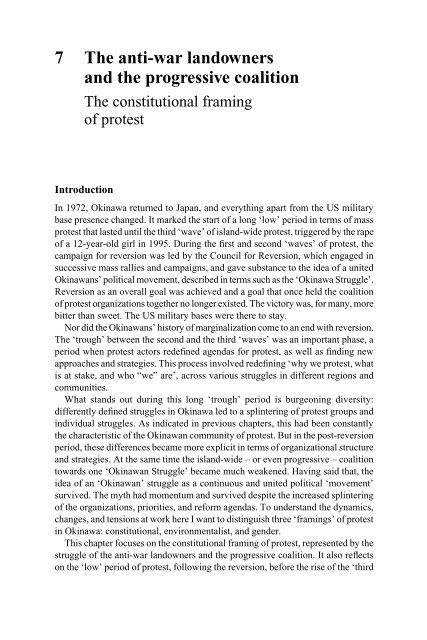Myth, Protest and Struggle in Okinawa
Myth, Protest and Struggle in Okinawa
Myth, Protest and Struggle in Okinawa
You also want an ePaper? Increase the reach of your titles
YUMPU automatically turns print PDFs into web optimized ePapers that Google loves.
7 The anti-war l<strong>and</strong>owners<br />
<strong>and</strong> the progressive coalition<br />
The constitutional fram<strong>in</strong>g<br />
of protest<br />
Introduction<br />
In 1972, Ok<strong>in</strong>awa returned to Japan, <strong>and</strong> everyth<strong>in</strong>g apart from the US military<br />
base presence changed. It marked the start of a long ‘low’ period <strong>in</strong> terms of mass<br />
protest that lasted until the third ‘wave’ of isl<strong>and</strong>-wide protest, triggered by the rape<br />
of a 12-year-old girl <strong>in</strong> 1995. Dur<strong>in</strong>g the first <strong>and</strong> second ‘waves’ of protest, the<br />
campaign for reversion was led by the Council for Reversion, which engaged <strong>in</strong><br />
successive mass rallies <strong>and</strong> campaigns, <strong>and</strong> gave substance to the idea of a united<br />
Ok<strong>in</strong>awans’ political movement, described <strong>in</strong> terms such as the ‘Ok<strong>in</strong>awa <strong>Struggle</strong>’.<br />
Reversion as an overall goal was achieved <strong>and</strong> a goal that once held the coalition<br />
of protest organizations together no longer existed. The victory was, for many, more<br />
bitter than sweet. The US military bases were there to stay.<br />
Nor did the Ok<strong>in</strong>awans’ history of marg<strong>in</strong>alization come to an end with reversion.<br />
The ‘trough’ between the second <strong>and</strong> the third ‘waves’ was an important phase, a<br />
period when protest actors redef<strong>in</strong>ed agendas for protest, as well as f<strong>in</strong>d<strong>in</strong>g new<br />
approaches <strong>and</strong> strategies. This process <strong>in</strong>volved redef<strong>in</strong><strong>in</strong>g ‘why we protest, what<br />
is at stake, <strong>and</strong> who “we” are’, across various struggles <strong>in</strong> different regions <strong>and</strong><br />
communities.<br />
What st<strong>and</strong>s out dur<strong>in</strong>g this long ‘trough’ period is burgeon<strong>in</strong>g diversity:<br />
differently def<strong>in</strong>ed struggles <strong>in</strong> Ok<strong>in</strong>awa led to a spl<strong>in</strong>ter<strong>in</strong>g of protest groups <strong>and</strong><br />
<strong>in</strong>dividual struggles. As <strong>in</strong>dicated <strong>in</strong> previous chapters, this had been constantly<br />
the characteristic of the Ok<strong>in</strong>awan community of protest. But <strong>in</strong> the post-reversion<br />
period, these differences became more explicit <strong>in</strong> terms of organizational structure<br />
<strong>and</strong> strategies. At the same time the isl<strong>and</strong>-wide – or even progressive – coalition<br />
towards one ‘Ok<strong>in</strong>awan <strong>Struggle</strong>’ became much weakened. Hav<strong>in</strong>g said that, the<br />
idea of an ‘Ok<strong>in</strong>awan’ struggle as a cont<strong>in</strong>uous <strong>and</strong> united political ‘movement’<br />
survived. The myth had momentum <strong>and</strong> survived despite the <strong>in</strong>creased spl<strong>in</strong>ter<strong>in</strong>g<br />
of the organizations, priorities, <strong>and</strong> reform agendas. To underst<strong>and</strong> the dynamics,<br />
changes, <strong>and</strong> tensions at work here I want to dist<strong>in</strong>guish three ‘fram<strong>in</strong>gs’ of protest<br />
<strong>in</strong> Ok<strong>in</strong>awa: constitutional, environmentalist, <strong>and</strong> gender.<br />
This chapter focuses on the constitutional fram<strong>in</strong>g of protest, represented by the<br />
struggle of the anti-war l<strong>and</strong>owners <strong>and</strong> the progressive coalition. It also reflects<br />
on the ‘low’ period of protest, follow<strong>in</strong>g the reversion, before the rise of the ‘third
















